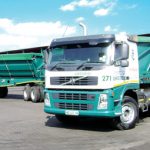Geared for success

In global vehicle manufacturing terms, Hyundai Motor Company is a relatively young company, with the first vehicle rolling off the line in 1967. This has not prevented it from fast becoming one of the top five automotive manufacturers in the world.
In fact, the company’s youthful enthusiasm and energy have helped it achieve successes that other, more historic manufacturers can only dream of.
Hyundai Motor Company opened its first plant exclusively for the manufacturing of commercial vehicles in 1995 in JeonJu, South Korea. The plant stretches over a land area of 1 300 000 m2 and 400 000 m2 of floor space, making it one of the largest commercial vehicle manufacturing facilities in the world. Hyundai is able to roll out 107 600 medium- and heavy-duty trucks, as well as 17 400 buses from this facility every year.
Charged with the distribution of Hyundai’s passenger and commercial vehicles in South Africa, Hyundai Automotive South Africa has experienced tremendous growth. Hyundai vehicles have become a familiar sight on our roads. Vehicles such as the Atos, Getz, Tucson and H100 bakkie all form part of this brand and the success of these models has given Hyundai a firm local footing.
The H100 in particular is the light commercial vehicle of choice for many contractors and delivery companies. Recently, Hyundai expanded its offering in the light commercial vehicle segment with the introduction of the H1 Wagon, a nine-seat van, and the H1 Panel Van, a useful addition to any company fleet.
The recent economic downturn and decline of sales in the commercial vehicle segment created a fiercely competitive environment. This forced Hyundai to rethink its strategy and refocus its commercial vehicle business, and the decision was made to split the manufacturer’s passenger and commercial vehicle divisions.
“Obviously, commercial vehicle sales were the hardest hit during the recent economic slowdown”, says Ettienne du Preez, the newly appointed general manager of the commercial vehicle division at Hyundai Automotive South Africa. “When passenger vehicle sales dropped by between 20 and 30% year-on-year, the commercial vehicle segment declined by 35% and over. In some cases, even as much as 50%.
“Our customers went into survival mode as their business opportunities started drying up. As a result, they tended to hang on to their existing fleet for longer than normal, opting to replace vehicles only once they saw a positive turn.
“Although our sales were affected, the downturn wasn’t all negative though. It afforded us the opportunity to relook our product offering and refocus our business. We invested heavily in enhancing our product offering, especially on the medium commercial side. We also increased our sales and technical training efforts. Next year should be a good one for us.”
Hyundai is also developing right-hand-drive products for the heavy commercial vehicle segment and plans to launch them toward the end of 2010.
With the 2010 FIFA Soccer World Cup around the corner, the excitement at Hyundai is reaching boiling point. Since 2002, Hyundai has been one of only six FIFA Partners and, as a result, is involved with every competition that FIFA hosts, from the Club World Cup and under-17 World Cup to FIFA’s crown jewel, the FIFA Soccer World Cup. Apart from the obvious marketing exposure, Hyundai will also be providing a large number of passenger and commercial vehicles.
“During the recent Confederations Cup, all the participating teams were transported in our luxury 39-seat coach, the Hyundai Universe,” said Du Preez. “We aim to do the same during the World Cup.
“It is a proud moment for us to see the teams arrive at the stadium in one of our coaches. It also shows the trust FIFA has in our products. If the teams don’t arrive at the stadiums, there is no tournament. It’s a huge responsibility, but a very rewarding one.”
It seems that without Hyundai vehicles, the 2010 FIFA Soccer World Cup would simply not move.
Published by
Focus on Transport
focusmagsa




